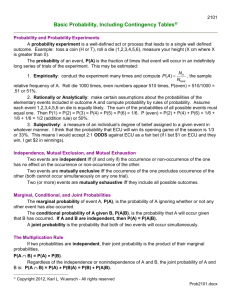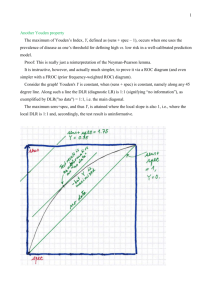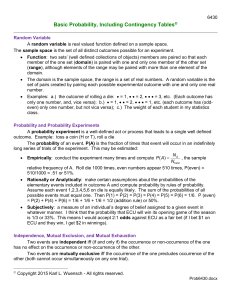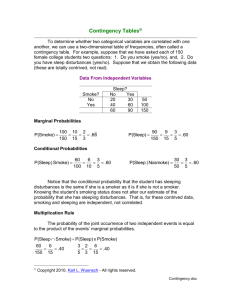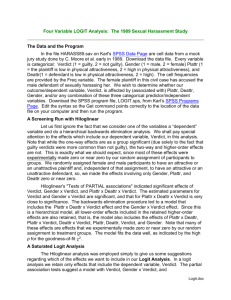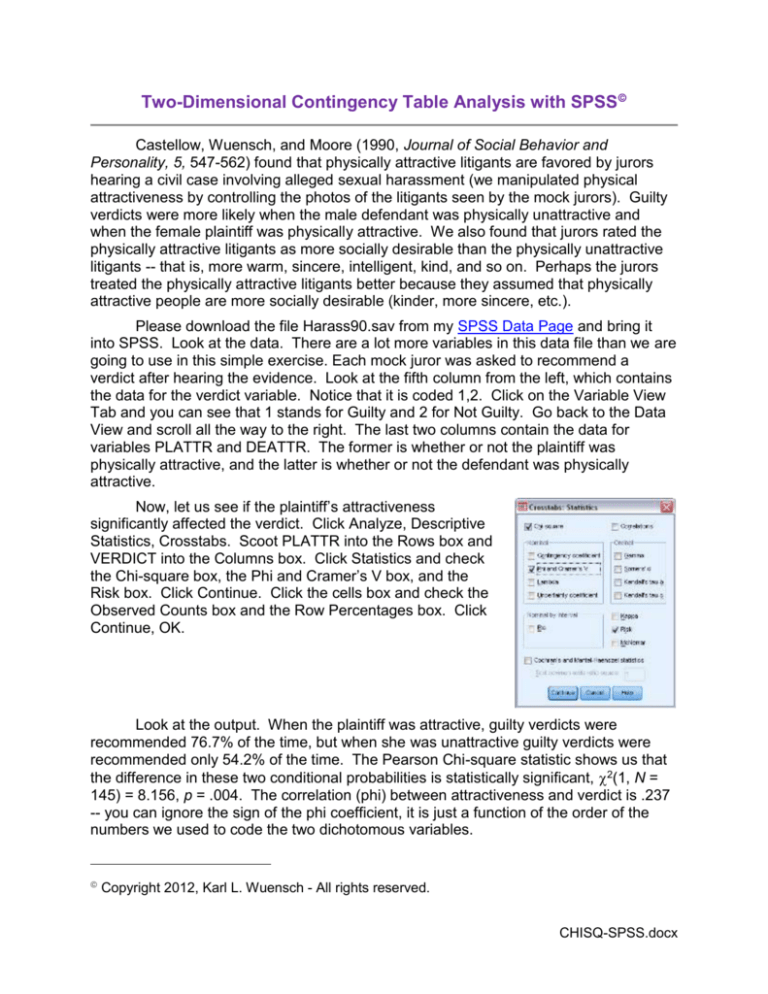
Two-Dimensional Contingency Table Analysis with SPSS
Castellow, Wuensch, and Moore (1990, Journal of Social Behavior and
Personality, 5, 547-562) found that physically attractive litigants are favored by jurors
hearing a civil case involving alleged sexual harassment (we manipulated physical
attractiveness by controlling the photos of the litigants seen by the mock jurors). Guilty
verdicts were more likely when the male defendant was physically unattractive and
when the female plaintiff was physically attractive. We also found that jurors rated the
physically attractive litigants as more socially desirable than the physically unattractive
litigants -- that is, more warm, sincere, intelligent, kind, and so on. Perhaps the jurors
treated the physically attractive litigants better because they assumed that physically
attractive people are more socially desirable (kinder, more sincere, etc.).
Please download the file Harass90.sav from my SPSS Data Page and bring it
into SPSS. Look at the data. There are a lot more variables in this data file than we are
going to use in this simple exercise. Each mock juror was asked to recommend a
verdict after hearing the evidence. Look at the fifth column from the left, which contains
the data for the verdict variable. Notice that it is coded 1,2. Click on the Variable View
Tab and you can see that 1 stands for Guilty and 2 for Not Guilty. Go back to the Data
View and scroll all the way to the right. The last two columns contain the data for
variables PLATTR and DEATTR. The former is whether or not the plaintiff was
physically attractive, and the latter is whether or not the defendant was physically
attractive.
Now, let us see if the plaintiff’s attractiveness
significantly affected the verdict. Click Analyze, Descriptive
Statistics, Crosstabs. Scoot PLATTR into the Rows box and
VERDICT into the Columns box. Click Statistics and check
the Chi-square box, the Phi and Cramer’s V box, and the
Risk box. Click Continue. Click the cells box and check the
Observed Counts box and the Row Percentages box. Click
Continue, OK.
Look at the output. When the plaintiff was attractive, guilty verdicts were
recommended 76.7% of the time, but when she was unattractive guilty verdicts were
recommended only 54.2% of the time. The Pearson Chi-square statistic shows us that
the difference in these two conditional probabilities is statistically significant, 2(1, N =
145) = 8.156, p = .004. The correlation (phi) between attractiveness and verdict is .237
-- you can ignore the sign of the phi coefficient, it is just a function of the order of the
numbers we used to code the two dichotomous variables.
Copyright 2012, Karl L. Wuensch - All rights reserved.
CHISQ-SPSS.docx
2
Computing an odds ratio should give us a good feeling for the strength of the
effect of physical attractiveness. When the plaintiff was physically attractive, the odds of
a guilty verdict were 56 to 17 -- that is, a guilty verdict was 3.3 times more likely than a
not guilty verdict. When the plaintiff was not physically attractive, the odds of a guilty
verdict were 39 to 33 -- that is, a guilty verdict was 1.2 times more likely than a not guilty
56 17
2.8 -- that is, when the plaintiff was physically
verdict. The odds ratio is
39 33
attractive the odds of a guilty verdict were 2.8 times higher than they were when she
was not physically attractive.
Look at the output. In the “Risk Estimate” box SPSS gives and odds ratio of
0.359. That is, the plaintiff was NOT physically attractive, the odds of a ruling in her
favor were only .359 of what they were when the plaintiff was physically attractive.
Odds ratios less than 1 confuse many people. I recommend that you invert them. In
this case, 1/.359 = 2.8, same as calculated above.
We should report a strength of effect estimate. If we have a 2 x 2 contingency
table, we can use the phi coefficient or the odds ratio. If we have a more complex table,
we can use the Cramer’s phi. If we report an odds ratio (my preferred measure), we
should also report a 95% confidence interval around that odds ratio. SPSS reported the
confidence interval as [.176, .732]. Inverting to avoid the odds ratios from being less
than 1, the confidence interval is [1.37, 5.68].
Presenting the Results of a 2 x 2 Contingency Table Analysis
Mock jurors were significantly more likely to find the defendant guilty when the
plaintiff was attractive (76.7%) than when she was unattractive (54.2%), 2(1. N = 145)
= 8.156, p = .004, odds ratio =2.78, 95% CI [1.37, 5.68].
Now you conduct the analysis to determine whether or not the verdict was
significantly affected by the defendant’s physical attractiveness. Be prepared to
report and interpret the results of your analysis in class.
Let us try another data set, from the article "Stairs, Escalators, and Obesity," by
Meyers et al. (Behavior Modification 4: 355-359). The researchers observed people
using stairs and escalators. For each person observed, the following data were
recorded: Whether the person was obese, overweight, or neither; whether the person
was going up or going down; and whether the person used the stairs or the escalator.
Please download the file Escalate.sav from my SPSS Data Page and bring it into
SPSS. Look at the data. Each line of data represents one cell in a 3 x 2 x 2
contingency table. The first score represents weight category for the cell, the second
score the direction traveled, and the third score the device used to travel. The fourth
score is the frequency for that cell. If the contingency table has already been
constructed, this is a much more efficient way to feed the data to SPSS than is having
one line for each subject.
Click Data, Weight Cases. Select Weight Cases By and then scoot the FREQ
variable into the Frequency Variable box, like this:
3
Click OK.
Click Analyze, Descriptive Statistics, Crosstabs. Scoot Direct into the rows box
and Device into the columns box. Ask for Pearson Chi-square, phi, observed counts,
and row percentages. OK.
Look at the output. We see that a significantly greater number of people use the
stairs when doing down (24%) than when going up (6%). The magnitude of this
correlation between direction and device, as expressed by the phi coefficient, is .26.
Another way to express this relationship is by an odds ratio. When going down, the
odds that the stairs were used was 331/1031 = .3210. Going up, these odds were
114/1741 = .0655. The odds ratio is .3210/.0655 = 4.9. In other words, the odds of
using the stairs were nearly 5 times higher when going down than when going up.
Now you conduct the analysis to determine whether or not the device used
was significantly affected by the subject’s weight. Be prepared to report and
interpret the results of your analysis in class. This is a 3 x 2 analysis.
From the overall analysis, you will find that choice of device is significantly
affected by weight category. To determine which weight categories differ significantly
from one another, you need to break the 2 x 3 contingency table into three 2 x 2 tables.
First we shall compare the overweight persons to the normal weight persons, ignoring
data from the obese persons. To make SPSS ignore the data from the obese persons,
go to the data sheet, variables tab. For the weight row, Missing column, click on the
little gray area with dots. The Missing Values window will open. Select Discrete
Missing Values and enter 1, as shown below. Click OK and then do the Weight x
Device analysis again.
4
After obtaining the results of the analysis comparing the overweight persons with
the normal weight persons, go back to the data sheet and define value 2, but not value
1, as being a missing value for the weight variable. Then do the crosstabulation
analysis again, this time comparing the obese individuals with the normal weight
individuals. Finally, return to the data sheet again and change the missing value from 2
to 3 and then conduct the crosstabulation analysis again to compare the obese group to
the overweight group.
I should add that there is a significant three-way effect in these data, but
conducting the multidimensional contingency table analysis to test it is beyond the
purpose of this document. You could get a partial picture of the three-way effect by
splitting the file by levels of one of the variables and then looking at the relationship
between the other two variables and each level of the split variable. From the
perspective illustrated below, the relationship between weight and device is different
when we consider only persons going up than it is when we consider only persons
going down.
5
Percentage Use of Staircase Rather than Escalator Among Three Weight Groups
30
25
20
Ascending
15
Descending
10
5
0
Obese
Overweight
Normal
In summary, people use the stairs much less than the escalator, especially when
going up. The overweight are the least likely to use the stairs when going up, but the
most likely to use the stairs when going down. Perhaps these people know they have a
weight problem, know they need exercise, so they resolve to use the stairs more often,
but using them going up is just asking too much.
Return to Wuensch’s SPSS Lessons Page
Copyright 2012, Karl L. Wuensch - All rights reserved.




